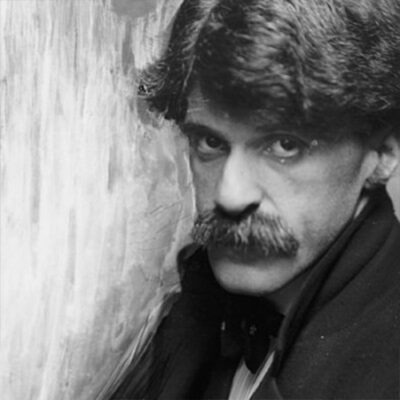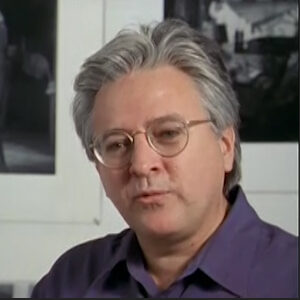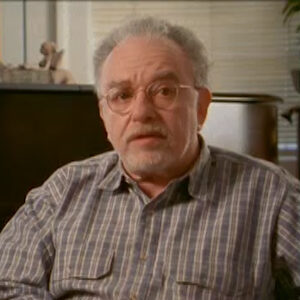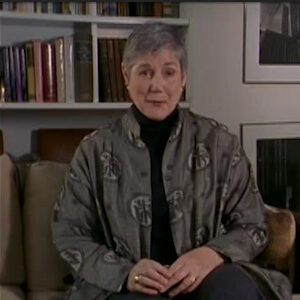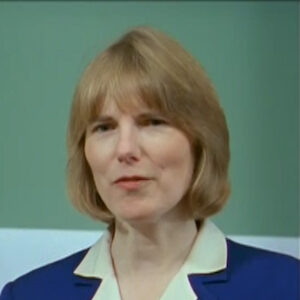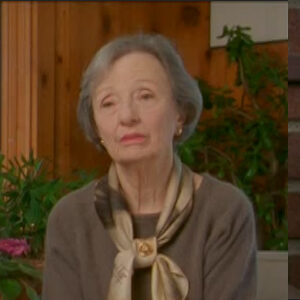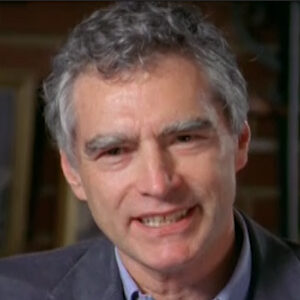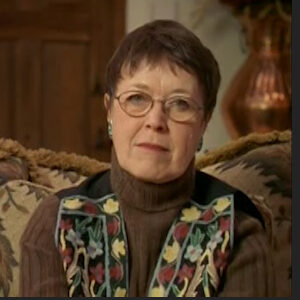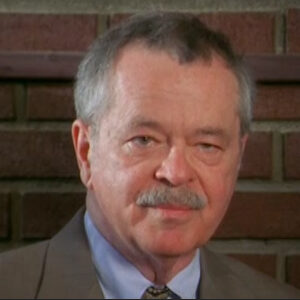Interviewer: In the amateur photography movement just before the start of the photo decision, was he important in the whole scene? What was he doing all this time?
Whelan: It’s important to remember that Stieglitz started out as a passionate amateur photographer. I think it puts things in perspective to know that. His friends at the New York Camera Club called him out. He was one of the guys who went to the club, which was very social, as well as for him and a few others, quite serious in terms of photography. But Stieglitz stood out because of the time he had spent in Europe and his exposure to the great European exhibitions that had begun to include photography, in some cases more or less, on a par with the other fine arts. And so Stieglitz, who was always dominating, always wanted to occupy the lead position, had grounds for doing so. He was looked up to his criticisms were taken very seriously. And what he began to do was, I think it’s important to bear in mind throughout Stieglitz, his career, that his mission was primarily spiritual, more than artistic. What he really wanted to do was to raise the level of spiritual life in America above what he saw as crass materialism by refining the sensibilities of the American public through the visual arts and through the other arts. But particularly through his chosen art of photography. And that was why he insisted so on the highest standards standard, far higher than most of the members of the New York Camera Club had any interest in.
Interviewer: Wonderful. Very important. Thank you. Tell us something that he was. He was mapping exhibitions that he did, but he was the editor of Camera Notes, looking at his activities. You know, I haven’t got that at all.
Whelan: Right from the beginning. Stieglitz was a man of many talents of diverse abilities, all of which she put to good use in the service of photography. He was, of course, a great photographer in his own right. But he was also a great critic of photography. A great connoisseur of photographic prints. A great darkroom worker, a great editor, a publisher. And so it was only natural that while he was a member of the New York camera club, he took what had been, in effect, a monthly broadside of social news about the members and transformed it into a blog publication of international standing showing the finest in photography, not only being done by members of the club, but by photographers from all over the United States and from abroad as well. This was the great magazine camera notes, the precursor of his.
Interviewer: One of the people what this.
Whelan: He.
Whelan: Devotion to raising the spiritual life of America was not only central to stimulus’s Life and his career, but to life and careers of many of the artists of his time who saw great possibilities of a new world in America, the world that had been promised throughout the 18th and 19th centuries, perhaps finally blossoming in the 20th century. Whitmanesque America that would jettison the philistinism and prudery and primness that had come to characterize so much of American life. These four what’s what Stieglitz was battling. Above all, his chosen medium of battle was photography. He felt that photography was an art with special virtue of training people to see what was truly beautiful. That is to say, spiritually beautiful in a sense around them in their most ordinary, everyday surroundings. That was what Stieglitz tried to accomplish and to a great extent did accomplish in his own work. And it’s what he respected in the work of so many others. This is why he photographed New York City. And like George, the two places where he actually lived. These were his militia. Early in his career, he believed he had to travel to exotic locations, to Italy and so on to find subjects. But very quickly, he realized that this this was not at all the aesthetic that he was looking for.
Interviewer: Contains a little bit about the where we where we are, the Provincetown Provincetown places Piglet’s come to tell us a little bit about.
Whelan: It’s singularly appropriate that we’re sitting here today in the Provincetown Playhouse in Greenwich Village because Stieglitz himself attended performances here. We know that he told a story of how he had come here in 1917 to see a bill of several of Eugene O’Neill’s one act plays about ships and the sea. And sitting just a few seats away from him was the great anarchist Emma Goldman, who had just been arrested quite recently for obstructing the military draft. The United States had, of course, just then entered World War One, and Emma Goldman told Stiglitz that she was about to be sent off to jail again. She had served his sentence some years earlier for her anarchistic activities and says Stiglitz and O’Keefe also came here to see plays. They were very cosmopolitan. They loved music. One of their closest friends was Paul Rosenfeld, who was a music critic and directed them to some of the best concerts in the city. Stieglitz was very much a part of the cultural life of New York, outside of the realm of the visual arts.
Whelan: What he was right to speak was feeling so frustrated.
Interviewer: Round 19 of what was it that he wasn’t that he wanted?
Whelan: Nineteen 02 was certainly a watershed year for statelets. A real turning point. It was then that his impatience with the lack of seriousness on the part of most of the camera club members really boiled over. He was being thwarted by political players within the camera club to impose his dictatorial way, his very high standards of what photography should be. And so he decided early in 1982 that he would form a an elite body of photographers, those whom he respected most. Edward Steichen, Clarets White Gertrude Case bear to name a few of the most prominent. This group was to be the photo session. The name referred only to the fact that the members were in theory, at least seceding from the camera club. In fact, they didn’t. They. They continued as members of the camera club, particularly in order to use its great darkroom facilities. But more importantly, the term succession was very important at that time throughout Europe as a key word, meaning essentially avant garde. A number of groups of artists in cities like Munich and Vienna had formed groups they called the secession, which represented the vanguard in all of the visual arts.
Interviewer: Something about the opportunity to. With sort of the big beginning of that.
Whelan: Well, I don’t know that I mentioned to Kay. I think I’ll just talk about the arts club. I think keep keep it simple. Stieglitz is opportunity to give form to his desire to to create a new organization was really coalesced by an offer from the National Arts Club to mount an exhibition of the finest of photography, both American and European, which would be curated by Stieglitz completely under his jurisdiction.
Whelan: And this was a landmark exhibition in the history of photography. Stieglitz gathered together the finest prints by the finest photographers. The exhibition enjoyed a great critical success. There were articles in the leading American magazines about pictorial photography, the kind of photography that Stieglitz was espousing, bringing for the first time, Stieglitz ideas and reproductions of the kind of work he admired to a much larger American public than he had reached hitherto. One of Stieglitz, his closest friends and coworkers, was a marvelous character named Kichi Hartman, who had been born in Japan. His father was a German merchant there who married his Japanese servant, who died when the child was very young. Sara Kichi was raised by relatives in Germany until he was threatened with having to go to a Naval Academy, which case in which he fled to America, went to Philadelphia mainly because Walt Whitman lived nearby in Camden, New Jersey. He befriended Whitman and soon the immensely talented Hartman became one of the most serious commentators on the visual arts. He was essentially self-taught. But through all his flamboyant style, which might have led one to think that he was something of a poseur. He was a very intelligent, very serious, very perceptive man who Stigler’s recognized as such and enlisted him as one of the principal mouthpieces for the photo session. To some extent. Hartmann echoed Stieglitz his own thoughts. But Hartman was always his own man, and most of what we read were his own very interesting insights into photography and the other visual arts as well.
Interviewer: You had said you had said something about that Stieglitz. It used him when it was impolitic to criticize. So it was kind of.
Whelan: Stieglitz was an outspoken man who made a lot of enemies right from the time when he was editing the magazine, the American amateur photographer in the mid to the middle. Well, I think I better start that over. Let me just get through a minute. Sorry. Stiglitz was always a very outspoken critic, and by speaking his mind very candidly, he naturally made a lot of enemies when he was the editor of a photographic magazine in the 80s, 90s. He had printed up some slips that said to respond to the work that subscriber’s sent in for criticism by the editors, Slips said. Technically perfect, pictorially rotten, and one can imagine there were a lot of constant cancellations of subscriptions, Stigler’s began to learn that an indirect approach was much more effective, that he did not want to become a focus of controversy himself when he could deflect that onto other critics. Kindred spirits who agreed with him, but also were willing to take a certain amount of direction from him. One of these was Sarda Kichi Hartman, who was not afraid of speaking his mind. And finally, as it turned out in 1984, Steiglitz had the very unpleasant experience of having Hartman to.
Interviewer: A little disappointed. Thirty seven. OK, let’s get a little bit about Carol.
Whelan: Camerawork was, without any question, one of the most beautiful magazines of any sort ever produced, everything from the quality of the paper, the choice of the typeface, the design of the cover, the printing of the photograph. Yours by the finest firm in Germany was of absolutely the highest standard. Stiglitz spent far more on the magazine than subscription payments ever covered. It was a very luxurious production, though not of a luxury that in any way overshadowed the work. It was a rather austere luxury of the finest materials, great seriousness, wonderful writers. Among the most notable being George Bernard Shaw and Gertrude Stein. The magazine carried work by many of the leading art critics of America and Europe. Writings by the photographers themselves. Photograph viewers that were so fine that Stieglitz loved to tell the story that when he had once shipped an exhibition of fine prints to Europe, the shipment didn’t arrive in time for the opening of the exhibition. So in desperation, the organizers of the show took some issues of camera work and removed the plates, framed them and nobody noticed any difference. They accepted them as photographic prints, the reproductions, the photograph viewers were hand pasted onto the pages covered with beautiful Japanese tissue paper. It really is one of the great pleasures to sit down with an original set of camera work and to go through them.
Whelan: This was something that has been of tremendous importance to many, many photographers in shaping their work.
Interviewer: Can you tell us something about its effect on water mission and its its influence, its effect?
Whelan: Camerawork, of course, started out as a photographic magazine exclusively. But to within about five years, Stiglitz radically changed the direction of the magazine to include modernist painting as well. He began public publishing reproductions of work by Matisse Picasso. And one can imagine the outrage of many of the subscribers who could see no relation to photography and then the work that Stieglitz was publishing. But it was very much Stigler’s had. I’m getting I’ve gotten lost in this. I’m sorry, but I know what I’m what I’m trying to do. But I can do it a lot simpler.
Whelan: Ask your question again, please, if you do,.
Interviewer: Do you think it can have an effect on modernist circles, on modernism? It wasn’t an influence.
Whelan: Although camera work naturally started out as a photographic magazine, Stieglitz quickly changed the direction of the illustrations, in particular by, oh, three or four years into the publication. When he began, including reproductions of work by Rhoda, Matisse, Picasso, and as he began to do so, the readership of camerawork expanded greatly. There were many cancellations from amateur photographers, but many of those cancellations were made up for by the leaders of modernism throughout America and in Europe. And the magazine had a tremendous impact. It, too, reached a relatively small but very elite audience of perhaps 600 people altogether as subscribers. But each issue would have been passed from hand to hand as a treasured document from the inner fortress of modernism in America.
Interviewer: You tell us something about what happened to two 91. What were some of the factors you tell us that two money went close? And why? Why do we have to close it after it so important?
Whelan: Stimulus’s gallery, which he called to 91 from its street address to ninety one Fifth Avenue. Though actually after 19 away, technically it was at 293 Fifth Avenue with Stiglitz, never let details like that bother him. The gallery like camerawork began to shift its direction in 1987. Nineteen eight away from simply showing photography to showing works of European modernist painting and gradually American modernism as well. And the first real competition to the gallery came in 1913 with the Great Armory Show held at one of the military armories here in New York City, bringing together by far the greatest cross-section of modernist work from here and abroad that had ever been seen in this country. And. After the great success of the Armory Show, a number of dealers began showing more and more modest work, and Stieglitz felt that it was less important for him to carry on his own work, that he had accomplished what he had set out to do. And it was now time to let others carry on what he had started.
Whelan: He didn’t want to become just another dealer. He never thought of himself as a dealer at all, for that matter. He was having financial problems. His wife’s income was limited, somewhat was decreased. That is by new restrictions on the production of beer, which is was the source of her family’s money. The entry of the United States into World War One complicated matters in many ways. Some of the artists were called into service, like Edward Steichen notably, and Stigler’s felt that also he wanted to get back to his own work as a photographer.
Whelan: He had devoted so much of his time to showing other people’s work that he really wanted to do his own photography. And therefore the gallery seemed to have come to a natural and it had run its course. It had served its purpose. It had accomplished its goals. Photography was widely recognized as a fine art. Modernism was increasingly recognized even by some of the great American museums. And so it was time to move on.
Whelan: When Stieglitz closed his gallery to 91 and simultaneously ended the publication of camerawork in 1917, at which time he was fifty three. He by no means went into retirement. If anything, one could say he really began a new life. Most notably the following year, when he began his first affair in a marriage with Georgia O’Keeffe, his photography took off as it had not. Sorry, I got bored. I got caught there. And I think you need. This is such a big question. Maybe we need to break this down a little bit. Couple questions.
Whelan: In 1917, when Stiglitz closed his gallery to 91 and ended the publication of camera work, he was 53. But he by no means went into retirement that time. He increasingly devoted his energies to a small group of American artists in whose work he believed passionately and would continue to believe passionately to the very end of his life. Georgia O’Keeffe, John Marrin, Marston Hartley, Arthur Dove and to a somewhat lesser extent, Charles DeMuth among photographers, notably Paul Strand and in the late teens and early 20s. Although Stieglitz didn’t have a gallery of his own, he mounted exhibitions of work by these people in other galleries and auction houses. Spaces that became available to him. He worked behind the scenes selling work to collectors. And he had a tremendous impact through his writing for other publications. This all led up in 1925 to one of his greatest exhibitions called Seven Americans, which included the work of of all of those as well, the people I’ve just mentioned. As long as well as his own photography.
Interviewer: But I think we need to think we need to redo the just the Ms.
Whelan: In 1925, Stieglitz mounted a large and very important exhibition called The Seven Americans, and it was the work of Georgia O’Keeffe. Marin Marston Hartley. Charles DeMuth and three photographers. Oh, yes. I’m sorry, Ms. Start. Start again. Yes. Yes. Well. Well, five. What am I doing. Five.
Interviewer: And to find my short.
Whelan: In 1925, Stieglitz organized a large and very important exhibition, which he called Seven Americans. It was included the work of five painters and two photographers. The painters were a Georgia O’Keeffe. Marcin Hartly, John Marrin, Arthur Dove and Charles DeMuth, the photographers were Paul Strand and Stieglitz himself. The show enjoyed very favorable critic, critical response. And so much so really that Stieglitz began to feel that perhaps it was time to open a new gallery to represent primarily the work of these artists.
Whelan: And thus, in the fall of that same year, 1925, he opened his gallery in a small room in the Anderson Galleries auction house, which Stieglitz called the intimate gallery.
Interviewer: The intimate gallery, the intimate gallery, an American place, but the intimate gallery.
Interviewer: So we have the. What was one of his aims? Something like the philistinism. What was going on in America at that time?
Whelan: OK.
Whelan: Stieglitz. Had an approach to representing artists and collecting the work of artists. That was quite different from what prevailed. This era of the 20s was the period in which the collections that would lead to the founding of the Museum of Modern Art and the Whitney Museum were being brought together. Stieglitz felt that that kind of collecting, very broad collecting. Duncan Phillips was another putting together that marvelous collection of the Phillips Collection in Washington. Stieglitz felt that it was a mistake to spread the wealth very thin among a great many artists, that it was important rather to choose a few. What we did stop until that that that’s distract.
Interviewer: From 1925 until the Richard.
Whelan: From 1925 until his death in 1946, Stieglitz would focus his energies on an increasingly smaller group of artists. Within this, seven Americans grew up until at the end it really consisted of essentially just O’Keefe, Marin and Duff. And there was a real philosophy behind this that Stieglitz felt it was vital to recognize the very finest artists working and to support them. And a very serious way not to buy one word from one artist and work from. From each of another hundred artists and putting together a representative collection. He felt that that really helped the artist very little, that an artist needed to have an income to do the work that was so important.
Whelan: And so Stieglitz encouraged collectors to collect in depth. He was always looking for an enlightened, wealthy person who would give an artist an allowance generous enough to free the artist of money worries. And since such people were very difficult to find, Stieglitz took on that role himself. He kept a running fund into which he put money he received from the sale of his own prints a percentage of the sale price of every work he sold from the gallery. Some of the money from his own independent income and use that fund to help artists in any way he could. People who he felt were really deserving, focusing always on his inter-group but occasionally making gifts to those of whom he felt were in special circumstances that justified his helping them.
Whelan: By in depth, some other people. He encouraged money to artists to tell.
Whelan: Stieglitz was. Constantly trying to enlighten American collectors. He would deliver fantastic harangue. He was a passionate speaker, a monologist who would go on. It would with great charisma for hours at a time, trying to make the point. Why? By the work of artists who are long dead, who cannot benefit from the purchase. Why not help artists who are alive who need the money now in order to do more work? One collector who responded quite well to this criticism to this enlightenment was Duncan Phillips of the Phillips Collection in Washington, who was very much in love with the work of Arthur Duff. And Stieglitz got Phillips to work out an arrangement by which he would buy a certain number of Dove works every year in return for an allowance. There were all sorts of problems, but it was certainly something that saved Dov’s life over and over again. It must be said, I think, that for all the emphasis that one hears on placed on stimulus’s antagonisms, his running feuds with artists, there were in particular two great friendships that speak to his credit more than any others. And those are his lifelong, virtually untroubled friendships with Arthur Dove and John Marrin.
Interviewer: Tell us something about the of the opening of an American place. Did he? He wanted to do another gallery.
Whelan: In twenty nine. It was 29.
Whelan: When Stieglitz received word in 1929 that the building in which the intimate gallery was located would be vacated by the auction house. That gave him the space at a very low rate. Stieglitz was ambivalent about establishing another gallery. But Dorothy Norman and Paul Strand in particular, strongly encouraged him to continue his work with the gallery. And they made it possible they found a space. They raised the rent. That is to say, they guaranteed their rent. And. Stieglitz focused his energies more and more on to his inter-group of O’Keefe dove, Narin Strand to some extent, Hartley, who came and went from one gallery to another. Always coming back to Stieglitz and. An American place was the gallery that Stieglitz had as a just a part of stars such just that.
Interviewer: Very good. Yeah.
Whelan: Stieglitz chose the name An American Place very deliberately. It was to be American in that he would show the work only of living American artists. He when Berniece Abbott showed him the work of John Jay, one of the great photographers of the 20th century. Stigler’s declined, recognizing the greatness of the work, but she was a dead Frenchman, not living American. So an American place. This was to be not a gallery. Not a place of business. It was to be simply a place where one could go and look at work. True, some works of art left the place after money had changed hands. But Stieglitz never considered himself a dealer. He never thought that he was selling work. He would allow. An enlightened collector to have the privilege of living with the war in Iraq in exchange for this privilege. The collector wants to give money to the artist that would allow the artist to live and to work.
Interviewer: A little bit. Also, tell me something that was an issue that she wants. So what we know about Steve, which I think is based on her writing.
Interviewer: Tell me a little bit about Dorothy Norman and her role.
Whelan: In the mid 20s. A young woman named Dorothy Norman wandered one day into the intimate gallery and was very taken not only by the works of John Marrin on the walls, but much more so by Stieglitz, who was in the middle of a very serious gestural conversation with several collectors. Soon, Norman returned to the gallery and. Really quite soon fell in love with Stiglitz on many levels. Primarily, they were kindred spirits. She was looking for. A father figure, so to speak. And.
Whelan: This isn’t working. Well, what do we need? What do you need? This is. Yeah. No, no. So.
Whelan: OK. Yeah.
Whelan: Yeah, but that’s that’s much more comfortable.
Interviewer: OK.
Whelan: In the mid 1920s, a wealthy young woman named Dorothy Norman wandered one day into the intimate gallery and was very taken not only by the works of John Marrin on the wall, but even more so by the person of Stieglitz who was in the middle of one of his passion conversations with the group of visitors over the coming years. Dorothy Norman would become absolutely central to stimulus’s his career and to his personal life as well, for the two of them fell very much in love with each other. But more important than the rather brief affair they had was Norman’s dedication to assisting Stieglitz, his work in any way she possibly could. Whether it was working as a secretary in the gallery, as a volunteer or campaigning to raise the money to pay the rent, she became fascinated by photography, and I was fortunate enough to receive lessons in photography from the master himself. Made many wonderful portraits of Stieglitz and accomplished enough to have a reputation of her own as a photographer. And she began collecting stories about Stieglitz whenever she returned home. At the end of the day, she would write down what she had overheard or what Stieglitz had told her memories from his past anecdotes, insights over the years, over many years. She accumulated a vast archive from which she edited several books, notably a wonderful biography of Stieglitz. In 1973.
Interviewer: Something about the Museum of Modern Art.
Interviewer: And if they have any.
Interviewer: Any effect on his decision to go? What was his attitude towards the.
Whelan: To Stieglitz, the. Museum of Modern Art.
Whelan: I get it. I think I have this relates to what I was saying about supporting a lot of artists. As opposed to a few artists. We.
Interviewer: Was done. I think his whole attitude was very sarcastic about. And that’s one of the reasons that.
Interviewer: This is what Wayne says in his book.
Whelan: When the Museum of Modern Art opened in 1929, Stieglitz had very mixed feelings about it. On the one hand, he thought it would be marvelous if the museum would give serious in-depth shows to artists whom he respected. But he feared that it was more likely that museum would devote its energies or, as he saw it, fritter away its energies, showing the work of a vast number of artists not really helping any one of them significantly. Stieglitz tended to dismiss the modern as little more than a hobby of a great group of rich women. Della Tot’s.
Interviewer: Tell me something about sequences of, uh, character.
Interviewer: Uh, what do you think? He fell and broke.
Interviewer: With so many people who were close to him? The photographer is an artist. Something about.
Whelan: Stieglitz. Held his opinions with. The utmost. I’m sorry, I just need to think about that.
Whelan: I. Yes. I want to say something. Focus this.
Whelan: One of the qualities central to Stieglitz is personality was his self-righteousness, which worked both for and against him.
Whelan: When he held an opinion. He knew he was right.
Whelan: He considered himself very much a scientist. And so. He believed that his beliefs were scientifically true and thus brooked no argument. This does now not allow a lot of room for argument. And since the matter’s under considers consideration, were of such high seriousness. The nothing short of the moral and ethical life of America. Stieglitz was, we might say, almost to kind of put that to, that he would excommunicate a heretic. That this was. That’s bad. Oh, sorry, sorry. One of the absolutely central elements in Stigler’s character was his self-righteousness. Which worked both for and against. He had studied science as a young man and felt himself very much a scientist in spirit. When he held an opinion, he believed indeed he knew that he was scientifically correct. And this approach really left little room for argument. One could say that Stieglitz saw himself as a kind of pope who would excommunicate heretics and not to. It wasn’t that Stieglitz was so contentious for the sake of contention. But he was dealing with matters of such high seriousness. Nothing short of the moral health of the United States and given the seriousness of his ambition. He was determined that he would cut.
Interviewer: Okay, you got that OK. Why did he quarrel and break with so many people, like who were some of the people he broke with, like pirates? Why? Casimir. And some of the individuals.
Whelan: Stieglitz. Unfortunately ended up quarrelling with a number of people who had been very close to him. Some of his dearest friends and some of the artists whose work he respected most such people as Edward Steichen, certainly Alvin Landon Coburn, Max Weber and.
Whelan: There were several reasons for this, notably, Stieglitz felt that he had such a clear vision of how an artist should live such high standards that when he felt an artist betrayed those standards.
Whelan: He. All right.
Whelan: I’m still this is this is a tough one because there’s so many people. Let’s to Steichen.
Whelan: That’s what I’m going to ask you. Let’s just focus on stuff, because that sums up the rest.
Whelan: Okay.
Whelan: It’s very unfortunate that over the course of his long life, Stiglitz quarreled with a number of the artists whom he liked best as people and whose work he respected most. Notable among them was Edward Steichen. Who had been Stieglitz, his protege, a Stieglitz that had a strongly paternal feeling to Steichen, had encouraged his career, had given him exhibitions, had published his work in many issues of camera work, and the strains in their friendship began to develop with the outbreak of World War One. Stieglitz felt that the United States should remain aloof from.
Interviewer: A little more effective break with the state than we already have a lot of effort to continue.
Whelan: Edward Steichen occupied a unique place both in Stieglitz is esteem and in Stieglitz, his strategy for getting photography accepted as a fine art. Stieglitz had been hoping to find someone who was both a very fine painter and a very fine photographer. And Steichen was that person. Stieglitz felt that Steichen would be able to make a very comfortable income from his work as an artist. And it was that belief that really led to the breakup. Eventually, their friendship, the strains began to show in the early years of World War One, when the two men differed strongly about America’s role in the war. But it wasn’t really until after the war when Steichen gave up painting and moved entirely to photography, that the two men came to the breaking point. One might say, I think that while Stieglitz remained always an elitist. Steichen increasingly became a populist. He saw himself as a photographer who could do work of a standard that could satisfy statelets. But it could reach an enormously broad popular audience through particularly the Condé Nast magazines. And this is precisely what Steichen proceeded to do. His portraits of virtually every celebrity. For Vanity Fair and for Vogue. His work as a fashion photographer brought Steichen himself in great celebrity and a lot of money. He was the highest paid photographer in the world. But Stieglitz felt that Steichen had sold out. Stieglitz could never forgive Steichen for having done so.
Interviewer: Did they ever make up? Did they ever make.
Whelan: The. The break was.
Whelan: Effectively.
Whelan: Lifelong. There were attempts, moves towards reconciliation, particularly in the last years of Stieglitz, his life during World War Two.
Whelan: Steichen wrote quite a nice article about Stieglitz in the photo session. And suddenly the two men didn’t remain on feuding terms, but they never returned to close friendship.
Interviewer: Could you, uh, you want to mention something about, um, about scran, the bracelets? Because that was very important, just.
Whelan: Stieglitz has break with Paul Strand was of a very different nature from his break with Steichen. In the case of Strand, the father son, feelings that had certainly been an important part of the Stieglitz Steichen friendship were much more exaggerated. Strand was not nearly as strong a person as a young man as Steichen has had been. Strand. Really worshipped Stieglitz and was very much in competition with him. And Stieglitz welcome the competition because he felt he could always get the best of it. But to gradually, this became more and more of a strain. But what finally brought about an irreconcilable break was political difference, that with the coming of the Great Depression. Strand, who, after all, had helped to establish an American place. Turned away when he felt that Stieglitz. Was using an American place as an ivory tower. It was high up in a skyscraper in mid Manhattan, Strand, who had always been a man of the left. Moved farther and farther to the left, as so many people did. With the rise of fascism, the communists were the only group strongly opposing the rise of Hitler. And Strand felt that Stieglitz had become irrelevant by not taking a much stronger political stance than he did.
Interviewer: Did he also feel that? Sievers’s individualism is one of the things that members have had cause trouble.
Whelan: Less so, it was more just party line.
Whelan: Really, it was more. I can talk a little bit about that. Let me think.
Whelan: In the early 30s. Strand began to move away from still photography, from the very refined art photography of which he was such a master taking after Stieglitz Strand moved increasingly to cinema. Cinema was the art par excellence of the Soviet Union. The art form that could reach the masses, that could propagandize to the masses. And much of the of the break came. Stieglitz remained in his highly individualistic attitude towards art. Strand moved more towards art as a political tool, an idea that Stiglitz abhorred. And Strand, for his part, saw spoke at one point of Stieglitz essentially fiddling while Rome burns.
Whelan: I feel. That.
Whelan: There’s no question that Stieglitz was most important as a catalyst. He was a man with a vision and an energy and capability to bring people of widely diverse interests, but similar sympathies together to work together. He was a great disseminator of ideas. I think that through to 91 and through camerawork particularly, he made his greatest contribution of exposing the American public to the great photography of America and Europe, of early Marrin early modernist art showing some of the finest young artists of his generation or of generations younger than than him in most cases. And I think it’s through that work, through his vision, through his philosophy that Stieglitz is more important. Certainly, even then, as a photographer, I hesitate to say that I think while he was a very fine photographer, there is a coldness. About Steiglitz, his work as a photographer. That is a serious limitation. I think that he certainly. It’s a very fine word, but I believe that his photography would not be so admired if it were not for what he was as a person. He, in effect, created a context for his work, and just as in his own view, in effect, art was always a means to an end. Art was a way of educating the public to a higher moral spiritual standard. I think this is true of his own work. His own photography was ultimately a means to an end.

